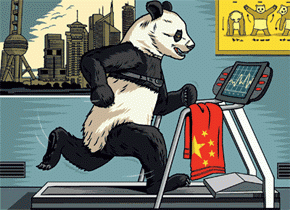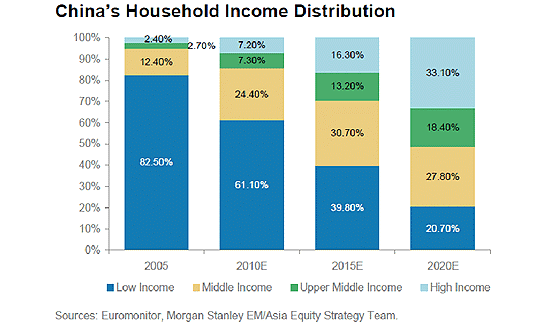
By Jonathan Wu*
[This is the third and final in this series on China. The first one is here, the second one here. ]
As the broad public focus their attention on slowing growth, a debt fuelled credit crisis, human rights issues etc, everyone seems to be missing the most important issue facing China over the next decade: Its population.
If one reflects on social unrest and uprisings in the last few years, there is only two reasons that caused this: a population’s living standards are very low, or they were very high and now their standards are being lowered.
Case in point includes Spain, Greece, Egypt and Tunisia.
For China, they have come a long way by bringing over 500 million people above the poverty line over the last 3 decades.
The challenge they face now is how to ensure the largest part of their population is the middle class.
This is depicted to the chart below where the middle class is made up of Middle Income and Upper Middle Income households.

The way to achieve this (and this is a challenge) is to increase the urbanisation rate. This is step one of many.
As part of the urbanisation process, the government is also extending reforms into providing universal healthcare coverage.
The previous leadership in 2012 achieved 96% coverage to the 50% of urban residents in China who are now receiving basic coverage. On top of this, the government is creating a pension/superannuation system as well as providing free universal education.
These three initiatives over the next 10 years will provide the population with increased living standards and hence mitigating the risk of social unrest.
This in turn will also mean the population will spend more.
Consumer confidence in China at the moment is very strong, which is reflected through the Nielsen China Consumer Confidence index which rose to 110 for the second quarter, up from 108 in the first quarter. A reading above 100 signals optimistic expectations. In comparison, the Nielsen global consumer confidence index was still at 94 for the second quarter.
The consumer confidence in China means an increased willingness to spend on improving their own quality of life.
The average disposable income of an urban resident was US$2,201 in H1 2013, up 9.1% compared to a year earlier, while rural residents had a boost to their disposable income of 13% compared to a year earlier.
Retail sales also reflects this sentiment with an increase of 12.7% in the first half of 2013.
As urbanisation overall in China increases, so will the population’s view of consumption and spending. When it does hit this point, then you will have a sustained middle class and subsequent sustainable growth for China.
As with any urbanisation process, with income levels rising, there then comes a range of opportunities for investment.
If the population achieves higher levels of disposable income, then spending increases on such things as luxury goods, motor vehicles, medicines, will become the norm (as we experience here in Australia), which are currently at incredibly low penetration rates.
Cars as an example, there are still only less than 50 cars per 1000 population in China compared to Australia at 650 cars. Universal healthcare has only reached the urban residents and medicines are still not mass marketed like the West as yet. Luxury goods such as phones, laptops, handbags are all still in its infancy.
This is where growth is headed and certainly not the export market where so many now fail to realise.
1.35 billion people are currently striving for a better living standard, and as the labour force itself becomes more productive over time, this will also fuel growth.
The urbanisation “prophecy” for China is bulletproof in the sense that its predecessors being Europe, the UK, the US and Japan have all achieved it with tremendous success, and China now has the benefit of hindsight to see what worked well and what didn’t work in previous mass urbanisation shifts, and generate a more stable and sustainable growth path for China.
With so many China bears drowning the market, the China bulls (of which we are just a few) are calling the market to recognise how cheap it is on a P/E basis.
As this weight of capital has left China of late, P/E’s are now sub 8x, and even local investors are still calling the Australian market 'cheap' at 12-13x.
As earnings continue to increase at approximately 5-10% for the rest of the year, these P/E’s may still fall, but it will come a point where people recognise value and what will be a once in a lifetime investment opportunity (that is, to buy into a market with such potential yet trading on negative sentiment).
So overall, we hope people refrain from jumping at shadows and focus on the real issues in China. Forget the shadows, and focus on substance.
-----------------------------------------------------------------------------------------
Jonathan Wu is an associate director at Premium China Funds Management. You can contact him here
2 Comments
Jonathan, your point is taken on the economic lessons of history as applied to China. What might be of more interest may be the politic turmoil that also followed the industrial revolutions.
To harness its economic power China must create a middle class. Unfortunately the political ramifications for such an emerging class are not pleasant for the current feudalistic style of government used.
It all sounds good until you consider the environment and then it all turns to custard.
As the Economist pointed out China is the biggest investor in green energy but still relies on CO2 producing fuels and their out put just goes on and on and up and up.
We welcome your comments below. If you are not already registered, please register to comment
Remember we welcome robust, respectful and insightful debate. We don't welcome abusive or defamatory comments and will de-register those repeatedly making such comments. Our current comment policy is here.